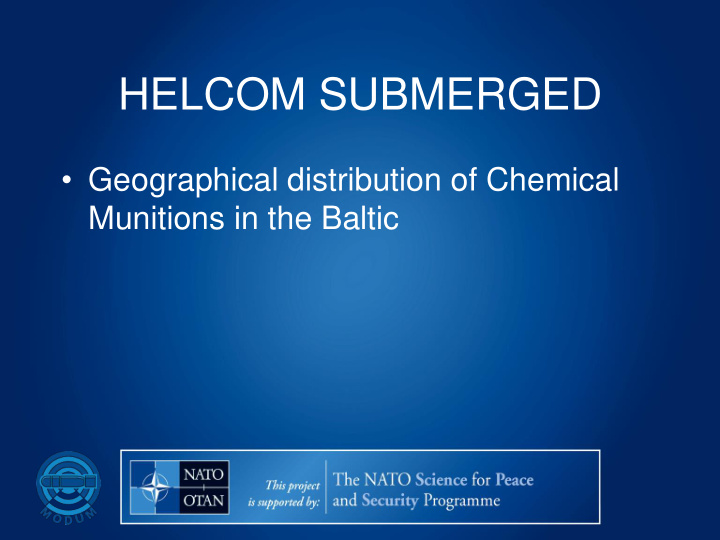



HELCOM SUBMERGED • Geographical distribution of Chemical Munitions in the Baltic
�
Chemical Munition Dumpsites • Gotland Basin • Bornholm Deep • Gdansk Deep • Little Belt Overview map of known and suspected dumpsites of chemical warfare materials.
Gotland Dumpsite WP4 Detection Area C: 1756 km 2 RSwN 4th NWF MWDC
Gotland Basin Gotland Basin Profile • Depth: 93-137 m Area • Ground: mostly thick layer of clayey according to current sea mud (0-6 m) • Size: 141,610 ha charts • Amounts 2,000 tonnes item-by-item (1,000 dumped tonnes payload) (approx.) • Sulfur mustard Chemical • Clark-types / arsine oil warfare agent • Adamsite types • α -chloroacetophenone • Tabun (suspected, found in Wolgast Distribution of bottom objects in the area of Gotland Deep. harbour) • Bombs, partly in wooden crates Container- • Grenades types • Bulk containers
Little Belt Little Belt Profile • Depth: 25-31 m Area • Ground: partly thick layer of mud (0-8 according to current sea m) • Size: 4,180 ha charts • Amounts 5,000 tonnes item-by-item (2,000 dumped tonnes payload, est. at 40%) • 1,250 tonnes on two barges (cargo (approx.) from barges recovered in 1959/60, payload 143 tonnes Tabun-mixture (DE Ministry for Interior 1960) • Tabun (found by investigations in 1955 Chemical Map of the designated and suspected dumpsite and transport warfare agent & 1959/60 (barges) and 1971/72 routes at the south of Little Belt. types (scattered items)) • Sulfur mustard (historical evidence) • Bombs (e.g. KC250), partly in wooden Container- types crates • Grenades (10.5 and 15 cm), fuzed (at least partly)
Bornholm Deep Bornholm Deep Profile • Depth: 93-137 m Area • Ground: mostly thick layer of clayey according to current sea mud (0-6 m) • Size: 67,260 ha charts • 32,000 Amounts tonnes item-by-item (Soviet dumped activities, 11,000 tonnes payload) • 30 tonnes item-by-item (GDR activities) (approx.) • 30 tonnes on scuttled hulk (GDR, 1962) Chemical Sulfur mustard (no evidence for nitrogen warfare agent mustard) • Clark-types / arsine oil types • Adamsite • α -chloroacetophenone • Phosgene (only GDR transports) Map of the designated and suspected ‘extended dumpsite’ at • Lewisite (found in on-site east of Bornholm, former transport routes from the loading investigations) port of Wolgast. • Tabun (suspected, found in Wolgast harbor) • Bombs (e.g. KC50 and KC250), partly Container- types in wooden crates • Grenades • Bulk containers • Spray cans • Wooden crates
Gdansk Deep Gdansk Deep Profile • Depth: 80-110 m (in the wider area) Area • Ground: muddy sediments according to • current sea Size: 100 ha (explosives dumping charts ground currently designated in sea charts) Amounts 60 tonnes dumped (approx.) Map of the Gulf of Gdańsk , indicating where the former • Sulfur mustard (two incidents in 1954) Chemical Explosives Dumping Ground is designated on sea charts. warfare agent types Container- Bombs (two incidents in 1954) types
Gdańsk Deep
Sampling in PEEZ
Chemical Munitions
Confirmed CWA
Fish disease index:
To change to to "View" and click "Header and
Degradation Products
Thank You for attention
Recommend
More recommend